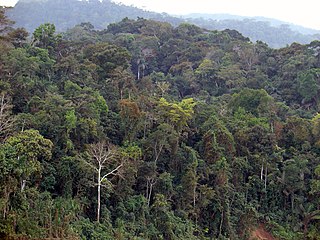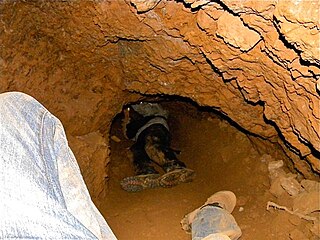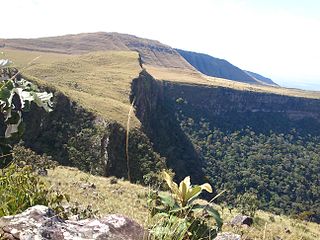
The Amazon rainforest, also called Amazon jungle or Amazonia, is a moist broadleaf tropical rainforest in the Amazon biome that covers most of the Amazon basin of South America. This basin encompasses 7,000,000 km2 (2,700,000 sq mi), of which 5,500,000 km2 (2,100,000 sq mi) are covered by the rainforest. This region includes territory belonging to nine nations and 3,344 formally acknowledged indigenous territories.

Madre de Dios is a department and region in southeastern Peru, bordering Brazil, Bolivia and the Peruvian departments of Puno, Cusco and Ucayali, in the Amazon Basin. Its capital is the city of Puerto Maldonado. It is also the third largest department in Peru, after Ucayali and Loreto. However, it is also the least densely populated department in Peru, as well as its least populous department. It has one of the lowest poverty rates in Peru.

Gold mining is the extraction of gold by mining.

Corcovado National Park is a National Park on the Osa Peninsula, in Osa Canton, located on the southwestern regions of Costa Rica, which is a part of the Osa Conservation Area. Corcovado National Park was established in October 24, 1975 and occupies an area of 424 square kilometres (164 sq mi). It is currently the largest park in Costa Rica and extends over about a third of the Osa Peninsula.

Environmentally, Colombia is a mega-diverse country from its natural land terrain to its biological wildlife. Its biodiversity is a result of its geographical location and elevation. It is the fourth largest South American country and only country in South America to have coasts on the Pacific and Caribbean Sea. Colombia's terrain can be divided into six main natural zones: The Caribbean, the Pacific, The Orinoco region, The Amazonia region, the Andean region, and the Insular region. 52.2% of the environment is predominately the Andes, Amazon, and Pacific Basins, followed by the Orinoco basin 13.9%, the Andes and the Caribbean. The Tropical Andes, Choco, and the Caribbean are considered biodiversity hotspots which puts these areas at high risk of concentration of colonizing activities. Colombia host over 1800 bird species and at least one new species are detected every year. Decades of civil war and political unrest have impeded biological and environmental research in Colombia. The political unrest in Colombia catalyzes the alteration of land patterns through the cultivation of coca and opium crops, the redirection of extractive activities, and land abandonment in some areas.

Lourenço is a town and district in the Brazilian municipality of Calçoene, in the interior of the state of Amapá. The main economic activities of the town is gold mining. It is one of the oldest mines in Brazil.

Peruvian Amazonia, informally known locally as the Peruvian jungle or just the jungle, is the area of the Amazon rainforest included within the country of Peru, from east of the Andes to the borders with Ecuador, Colombia, Brazil and Bolivia. This region comprises 60% of the country and is marked by a large degree of biodiversity. Peru has the second-largest portion of the Amazon rainforest after the Brazilian Amazon.

Brazil once had the highest deforestation rate in the world and in 2005 still had the largest area of forest removed annually. Since 1970, over 700,000 square kilometres (270,000 sq mi) of the Amazon rainforest have been destroyed. In 2001, the Amazon was approximately 5,400,000 square kilometres (2,100,000 sq mi), which is only 87% of the Amazon's original size. According to official data, about 729,000 km² have already been deforested in the Amazon biome, which corresponds to 17% of the total. 300,000 km² have been deforested in the last 20 years.

The Guajajara are an indigenous people in the Brazilian state of Maranhão. They are one of the most numerous indigenous groups in Brazil, with an estimated 13,100 individuals living on indigenous land.
Environmental issues in Brazil include deforestation, illegal wildlife trade, illegal poaching, air, land degradation, and water pollution caused by mining activities, wetland degradation, pesticide use and severe oil spills, among others. As the home to approximately 13% of all known species, Brazil has one of the most diverse collections of flora and fauna on the planet. Impacts from agriculture and industrialization in the country threaten this biodiversity.

Colombia loses 2,000 km2 of forest annually to deforestation, according to the United Nations in 2003. Some suggest that this figure is as high as 3,000 km2 due to illegal logging in the region. Deforestation results mainly from logging for timber, small-scale agricultural ranching, mining, development of energy resources such as hydro-electricity, infrastructure, cocaine production, and farming.

The Amazon rainforest, spanning an area of 3,000,000 km2, is the world's largest rainforest. It encompasses the largest and most biodiverse tropical rainforest on the planet, representing over half of all rainforests. The Amazon region includes the territories of nine nations, with Brazil containing the majority (60%), followed by Peru (13%), Colombia (10%), and smaller portions in Venezuela, Ecuador, Bolivia, Guyana, Suriname, and French Guiana.

Rates and causes of deforestation vary from region to region around the world. In 2009, two-thirds of the world's forests were located in just 10 countries: Russia, Brazil, Canada, the United States, China, Australia, the Democratic Republic of the Congo, Indonesia, India, and Peru.

Even though progress has been made in conserving Brazil’s landscapes, the country still faces serious threats due to its historical land use. Amazonian forests substantially influence regional and global climates and deforesting this region is both a regional and global driver of climate change due to the high amounts of deforestation and habitat fragmentation that have occurred this region.

An artisanal miner or small-scale miner (ASM) is a subsistence miner who is not officially employed by a mining company, but works independently, mining minerals using their own resources, usually by hand.
An immense number of bird species live in the Amazon rainforest and river basin. Over 1,300 of these species are types of birds, which accounts for one-third of all bird species in the world. The diets of rainforest birds greatly differ between species, although, nuts, fruits and leaves are a common food for many birds in the Amazon. Birds migrate to the Amazon rainforest from the North or South. Amazon birds are threatened by deforestation since they primarily reside in the treetops. At its current rate of destruction, the rainforest will be gone in forty years. Human encroachment also negatively affects the habitat of many Amazonian birds. Agriculture and road clearings limits the habitable areas. Birds in the Amazon are distinguished by which layer of the rainforest they reside in. Each layer or community has unique plants, animals and ecosystems. Birds interact with other animals in their community through the food chain, competition, mating, altruism and symbiosis.

Illegal mining is mining activity that is undertaken without state permission. Illegal mining is the extraction of precious metals without following the proper procedures to participate in legal mining activity. These procedures include permits and licenses for exploration of the land, mining and transportation.

The Serra Ricardo Franco State Park is a state park in the state of Mato Grosso, Brazil. It protects the edge of a plateau on the border with Bolivia in the region of transition from cerrado to Amazon rainforest. The park has been poorly protected and is badly degraded in areas by deforestation and conversion to pasturage. It is threatened by illegal squatters, hunting and burning.

The 2019 Amazon rainforest wildfires season saw a year-to-year surge in fires occurring in the Amazon rainforest and Amazon biome within Brazil, Bolivia, Paraguay, and Peru during that year's Amazonian tropical dry season. Fires normally occur around the dry season as slash-and-burn methods are used to clear the forest to make way for agriculture, livestock, logging, and mining, leading to deforestation of the Amazon rainforest. Such activity is generally illegal within these nations, but enforcement of environmental protection can be lax. The increased rates of fire counts in 2019 led to international concern about the fate of the Amazon rainforest, which is the world's largest terrestrial carbon dioxide sink and plays a significant role in mitigating global warming.

The environmental history of Latin America has become the focus of a number of scholars, starting in the later years of the twentieth century. But historians earlier than that recognized that the environment played a major role in the region's history. Environmental history more generally has developed as a specialized, yet broad and diverse field. According to one assessment of the field, scholars have mainly been concerned with "three categories of research: colonialism, capitalism, and conservation" and the analysis focuses on narratives of environmental decline. There are several currents within the field. One examines humans within particular ecosystems; another concerns humans’ cultural relationship with nature; and environmental politics and policy. General topics that scholars examine are forestry and deforestation; rural landscapes, especially agro-export industries and ranching; conservation of the environment through protected zones, such as parks and preserves; water issues including irrigation, drought, flooding and its control through dams, urban water supply, use, and waste water. The field often classifies research by geographically, temporally, and thematically. Much of the environmental history of Latin America focuses on the nineteenth and twentieth centuries, but there is a growing body of research on the first three centuries (1500-1800) of European impact. As the field established itself as a more defined academic pursuit, the journal Environmental History was founded in 1996, as a joint venture of the Forest History Society and the American Society for Environmental History (ASEH). The Latin American and Caribbean Society for Environmental History (SOLCHA) formed in 2004. Standard reference works for Latin American now include a section on environmental history.



















